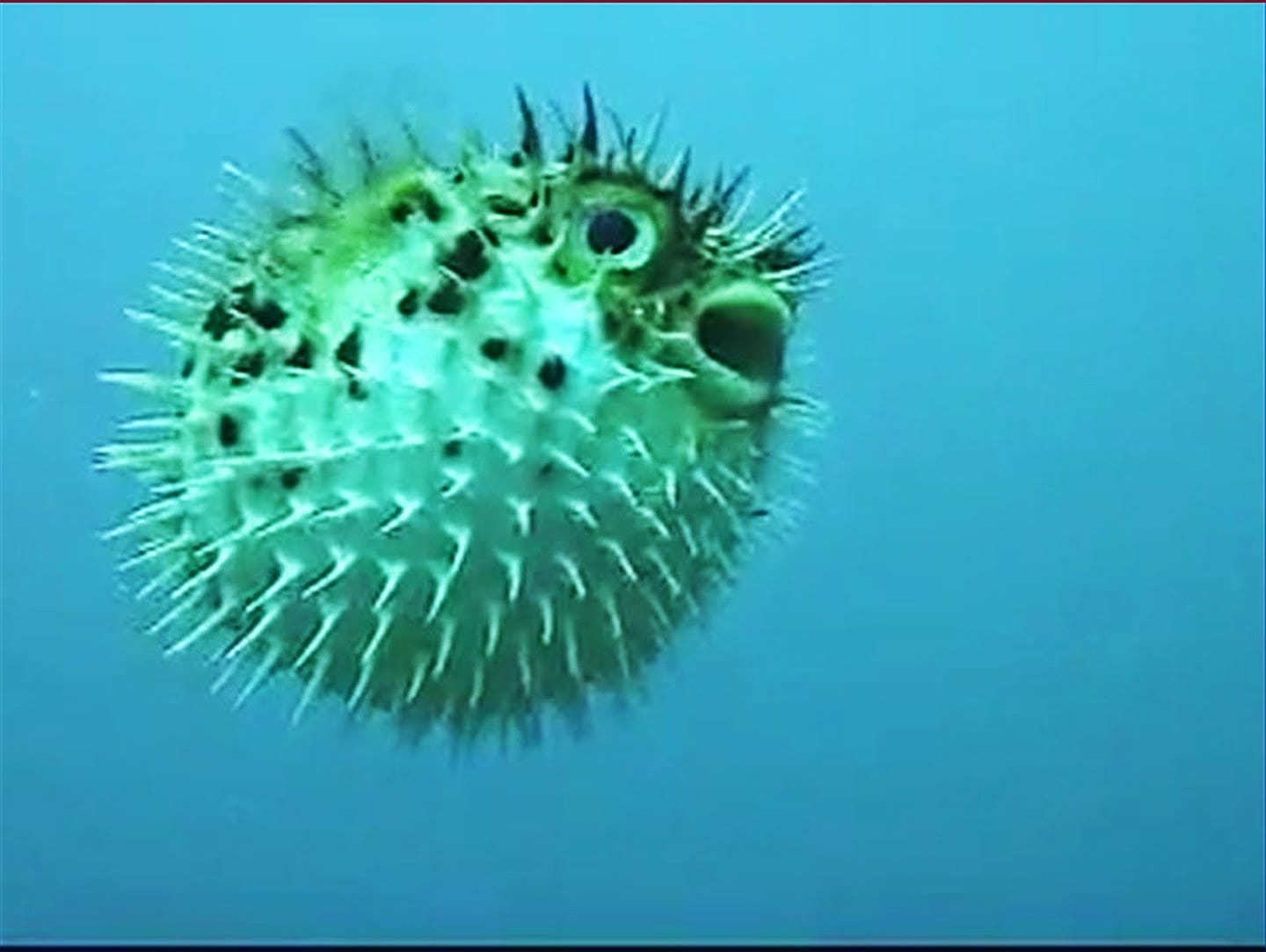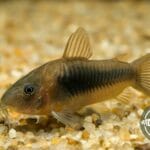Discovering the wonders of freshwater blowfish is like embarking on an exciting underwater adventure! These fascinating creatures, while not quite like the blowfish in ocean tales, are part of the Tetraodontidae group. From their intriguing behaviors to the right ways to care for them, get ready to dive into their world!
Unveiling the Mystery of Freshwater Blowfish
Freshwater blowfish, sometimes called puffers, are like the underwater superheroes of the fish world. They’re known for their unique ability to puff themselves up like a balloon when scared, which usually scares off any hungry predators.
Size, Variety, and Natural Habitat
These fascinating fish come in all sorts of sizes. The little dwarf puffer, or pea puffer, stays less than an inch long. On the other end of the spectrum, you’ve got the mighty Fahaka puffer (also known as the Nile puffer) that can grow to over a foot long! And just like their sizes, their personalities and food preferences are diverse too. Freshwater blowfish can be found in a surprising number of places – rivers, lakes, brackish water (a mix of fresh and salt), and even the ocean! Their teeth have evolved to be super strong, perfect for crunching on hard-shelled snacks like snails and crustaceans. Some pufferfish even enjoy a little fish or insect on the menu.
Bringing Home a Blowfish: Essential Considerations
If you’re thinking about having these fascinating creatures in your home aquarium, here are some important things to consider:
Tank Size is Crucial: A bigger tank is almost always better. It gives your blowfish space to explore, reduces any aggression issues, and just makes them feel more comfortable.
Feeding Your Puffer: A Balanced Diet: Just like us, blowfish need a variety of foods to stay healthy. Since their teeth are constantly growing, make sure to include plenty of crunchy foods that help them wear those chompers down.
Temperament: From Peaceful to Aggressive: Some blowfish are total softies and can live peacefully with tank mates. Others, not so much. Do your research beforehand to avoid any fish-on-fish violence!
Aquascaping: Creating a Comfortable Environment: Think caves, plants, rocks – anything that breaks up the line of sight and gives your blowfish some privacy. This can really reduce stress and help prevent any territorial spats.
Water Parameters: Striking the Right Balance: Just like Goldilocks and her porridge, blowfish like their water just right. And “just right” depends on the species. Research what your specific type needs in terms of pH, temperature, and salinity.
Popular Freshwater Blowfish Species
Ready to dive into the world of freshwater blowfish species? Here’s a peek at some of the most popular ones:
| Species | Max Size | Temperament | Favorite Foods | Special Notes |
|---|---|---|---|---|
| Dwarf Puffer | 1 inch | Peaceful | Snails, Bloodworms, Small Crustaceans | Great for nano tanks, needs those snails! |
| Fahaka Puffer | 1.4 feet | Aggressive | Fish, Crustaceans, Snails | Needs a huge tank, definitely not a community fish! |
| Figure 8 Puffer | 3 inches | Semi-Aggressive | Snails, Crustaceans, Frozen Foods | Enjoys brackish water (slightly salty) |
| South American Puffer | 4 inches | Aggressive | Snails, Crustaceans, Fish | Can be a challenge to care for due to their feisty personalities |
Ethical Considerations: Responsible Ownership
Bringing a blowfish home means taking on the responsibility of their well-being. One big thing to consider is their diet. Since many puffers rely heavily on snails, we need to think about where those snails are coming from. Overharvesting from the wild isn’t good for the environment. So, it’s important to explore alternative food sources or find suppliers who practice sustainable harvesting methods.
Conservation: Protecting Puffers in the Wild
Freshwater blowfish aren’t just cool aquarium pets; they play a vital role in their natural environments. They help keep ecosystems in balance and ensure we have diverse aquatic life. By understanding how important they are, we can all do our part to protect them through conservation efforts and responsible aquarium keeping.
FAQs About Freshwater Blowfish
Is There Really Such a Thing as a Freshwater Blowfish?
You bet there are freshwater blowfish! While many folks think of blowfish (or pufferfish, as they’re also called) as strictly ocean dwellers, there’s actually a whole bunch of these fascinating creatures thriving in freshwater rivers and lakes around the world.
These freshwater cousins share the same cool party trick as their saltwater relatives: puffing up like tiny, spiky balloons when danger’s around! It’s their way of saying “back off” to any hungry critters looking for a snack. Freshwater pufferfish come in a whole range of shapes, sizes, and personalities too. Some are mellow plant-munchers, while others are feisty hunters with a taste for snails and insects. It just goes to show, you can find puffers in all sorts of watery neighborhoods!
Are Freshwater Pufferfish Aggressive?
So, you’re thinking about those cute little puffers, huh? You know, the ones that puff up like balloons? They are fascinating, but like any roommate (with fins!), it’s good to know if they’ll be playing nice or starting fights. The truth is, it depends!
Some puffers are total sweethearts. Take dwarf puffers, for example. They’re usually cool with other peaceful fish. But then you have the fahaka puffers—they can be quite territorial and would rather be left alone. They need their own space, period.
Why all the fuss? Well, puffers can be a bit territorial. Imagine being stuck in a tiny room with a bunch of strangers—you’d probably get grumpy too! That’s why it’s super important to give them enough room to swim and explore. Plenty of hiding spots help too—it gives them a place to chill out if things get a bit too much.
Another thing to remember is that puffers are natural-born hunters. They’ve got those beaks for a reason! In the wild, they munch on snails and other critters. So, if their diet isn’t fulfilling their inner predator, they might start looking at their tank mates as snacks—not good! A steady diet of snails, crustaceans, and other meaty treats will keep them happy and less likely to nip at their neighbors.
Here’s the bottom line: puffers can be fantastic pets! They’re smart, funny, and full of personality. But like all living creatures, they have their quirks. With a little understanding and the right care, you can create a happy home for your puffer—and maybe even some tank mates, too!
Are Freshwater Pufferfish Poisonous to Humans?
So, we’ve talked about how these freshwater puffers, or puffers for short, have this cool defense mechanism where they puff up like a balloon when they feel threatened. It’s pretty amazing to see! But you might also be wondering, are these little guys dangerous to us? The answer is a bit complicated.
You see, freshwater pufferfish do have a toxin called tetrodotoxin, or TTX for short. This is the same stuff found in their saltwater cousins, and it’s seriously bad news. However, and this is important, the levels of TTX in freshwater puffers are generally much lower. That doesn’t mean they’re harmless, but it does mean they’re not quite as risky as some of their ocean-dwelling relatives.
The main danger with freshwater puffers comes from, you guessed it, eating them. Consuming any part of the fish, whether it’s the flesh, the organs, or even the skin, can lead to TTX poisoning. And let me tell you, TTX poisoning is not something you want to mess with. We’re talking numbness, tingling, and in severe cases, paralysis and even problems breathing. It can be really scary, and in some instances, it can even be fatal if you don’t get help right away.
This is why it’s super important to be a responsible pufferfish owner. If you’re thinking of getting one, do your research! Find out everything you can about the specific type of freshwater puffer you’re interested in, especially how toxic they are. There’s a lot of information out there, so make sure you’re getting it from reliable sources like experienced aquarists or experts in the field.
And remember, when it comes to handling your puffer, safety first! Always wear gloves, even if you’re just doing a quick tank clean. You don’t want any accidental scratches to turn into something more serious. And please, please, please, never, ever eat your freshwater pufferfish. That’s the golden rule for staying safe.
Remember, even though your puffer might seem healthy and happy, it’s always a good idea to keep an eye out for any signs of illness. Regular checkups with a vet who knows about fish are crucial. Taking these precautions will help keep your pufferfish healthy and you safe!
Do you want to own a galago for sale? Our galagos are hand-raised and socialized, making them perfect for families and experienced hobbyists. They’re also known for their large eyes, soft fur, and playful personalities. Check out our available galagos today!
The frilled dragon lizard is a unique and fascinating reptile that is native to Australia. It is known for its large, frilly neck, which it can extend to ward off predators or attract mates. Frilled dragons are also surprisingly good climbers and can often be found perching in trees.
















